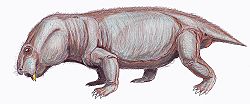| Kunpania | |
|---|---|
| Scientific classification | |
| Domain: | Eukaryota |
| Kingdom: | Animalia |
| Phylum: | Chordata |
| Clade: | Synapsida |
| Clade: | Therapsida |
| Suborder: | † Anomodontia |
| Clade: | † Dicynodontia |
| Clade: | † Bidentalia |
| Infraorder: | † Dicynodontoidea |
| Genus: | † Kunpania Sun, 1978 |
| Species: | †K. scopulusa |
| Binomial name | |
| †Kunpania scopulusa Sun, 1978 | |
Kunpania is an extinct genus of dicynodont therapsid from the Quanzijie Formation of Xinjiang, China. The type and only species is K. scopulusa, and it is known only by a single incomplete specimen including parts of the skull and forelimb. Since its initial description in 1978 by palaeontologist Ailing Sun, it has sometimes been considered to be another species of Dicynodon by other researchers, or potentially undiagnostic. However, a redescription in 2021 reaffirmed its distinctiveness, including a uniquely well developed muscle attachment on the humerus. Kunpania is perhaps the oldest known member of the derived dicynodont group Dicynodontoidea, potentially dating to the Middle Permian period during the Capitanian, and so may fill a knowledge gap in the history of dicynodont evolution.





